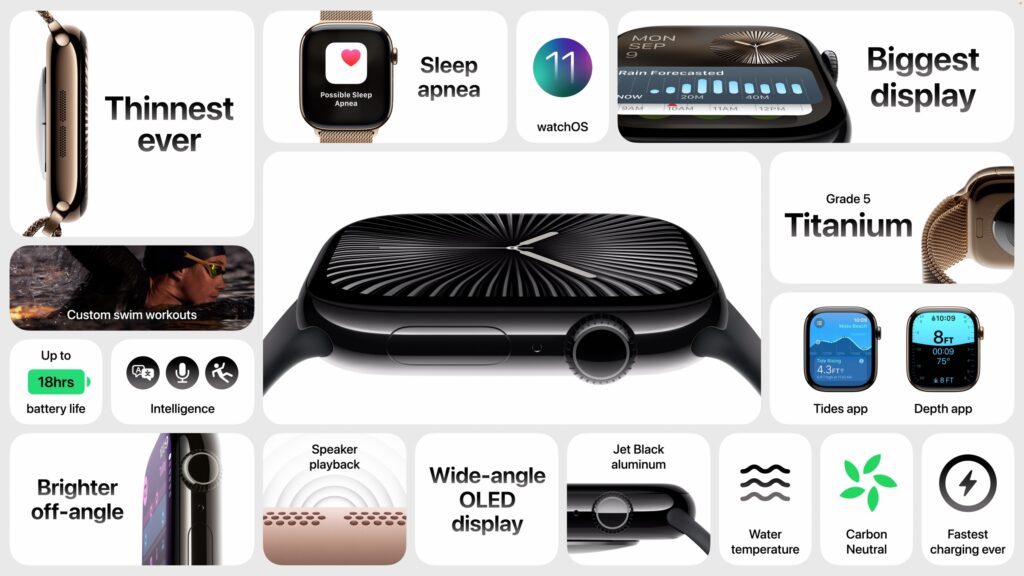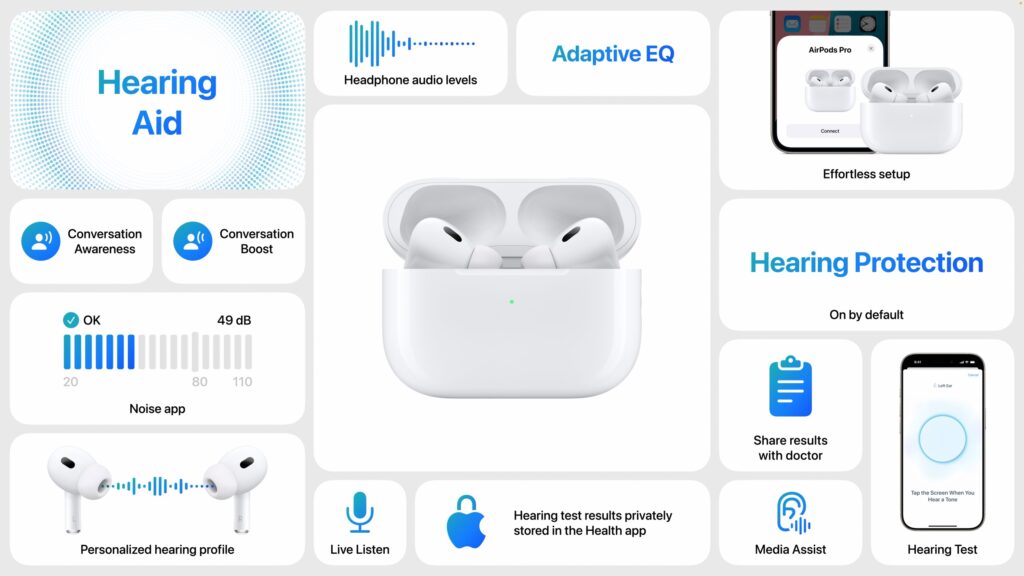Apple surprised many by introducing the Apple Watch Series 10 with a thinner, lighter design that still provides a larger, brighter screen and works with all existing bands. Apple also swapped stainless steel for lighter titanium in the higher-end models. Those expecting a new Apple Watch Ultra were disappointed; the existing Apple Watch Ultra 2 received a new black titanium finish and matching black Titanium Milanese Loop band.
Notable changes in the Apple Watch Series 10 include:
- Thinner and lighter: The new case is just 9.7 millimeters thick, nearly 10% thinner than recent models. The aluminum models are 10% lighter, whereas the new titanium models are 20% lighter than the previous stainless steel models.
- Larger, brighter display: The case sizes grow by 1 millimeter to 42mm and 46mm, but Apple increased the display size to provide 30% more screen area than the Apple Watch Series 4–6 and 9% more than the Apple Watch Series 7–9. The display is also 40% brighter when viewed from an angle and so much more power efficient that the Always-On display can now update once per second rather than once per minute.
- Faster charging: New features in watchOS 11 encourage wearing the watch at night, so Apple made the Apple Watch Series 10 charge to 80% in just 30 minutes. Daily use can be satisfied with 15 minutes of charging, and 8 minutes is all that’s necessary for overnight sleep tracking.
- Sleep apnea notifications: The Apple Watch Series 10 can identify sleep apnea by detecting interruptions in normal respiratory patterns using the accelerometer. Sleep apnea affects over 1 billion people worldwide, 80% of whom remain undiagnosed. The feature will also appear in watchOS 11 for the Apple Watch Series 9 and Apple Watch Ultra 2.
- Audio playback through speakers: Apps could generate audio through the speakers of previous Apple Watch models, but they couldn’t play music or podcasts. That’s now possible with the Apple Watch Series 10, letting you listen even if you’ve forgotten your AirPods.
- Depth and water temperature sensors: Divers will still want to focus on the Apple Watch Ultra 2, but the Apple Watch Series 10 now features a depth gauge that works down to 6 meters and a water temperature sensor.
- No blood oxygen sensing in the US: Although the pulse oximeter from previous models remains in the hardware and is available in other countries, a patent dispute prevents Apple from enabling it for units sold in the United States. If Apple can settle the dispute, the feature will become available with a software update.

The Apple Watch Series 10 starts at $399 for a 42mm aluminum GPS-only model; 46mm models cost $30 more, and cellular connectivity adds $100. It’s available in silver, rose gold, and a new polished jet black. Pricing for the titanium models starts at $699 for a 42mm model and includes cellular connectivity; the 46mm models are $50 more. Colors include natural, gold, and slate. Rubber and some textile bands are included at no extra cost; other textile and all stainless steel bands cost $50 to $300 more.
Stop by either store to figure out which Apple Watch is best for you!
If you don’t already have an Apple Watch Series 9 or Apple Watch Ultra 2, the sleep apnea notifications might be reason enough to upgrade. Being able to listen to podcasts without AirPods might also be compelling for some. Otherwise, there’s little reason to upgrade from an older but fully functional model. That said, the Apple Watch Series 10 is an excellent option for those getting started or upgrading from a much older version. Don’t forget that Apple still sells the Apple Watch SE, which lacks the Always-On display and ECG capabilities but is $150 cheaper. Apple’s comparison page can help you tease out the differences.
AirPods 4, USB-C AirPods Max, and Hearing Aid Feature for AirPods Pro
Apple released a notable update to its AirPods open-ear headphones, refining the AirPods 4 design to provide a single shape that fits more users. It boasts better sound quality thanks to a new acoustic architecture, low-distortion driver, and high dynamic range amplifier. With help from Apple’s custom H2 chip, the new AirPods provide Personalized Spatial Audio with dynamic head tracking, add voice isolation for clearer call quality in challenging environments, and let you respond to Siri announcements by nodding your head yes or shaking it no. The charging case now uses USB-C and can charge wirelessly using a MagSafe, Apple Watch, or Qi charger.
In fact, there are two models of the AirPods 4. (Really, Apple?) The AirPods 4 with Active Noise Cancellation retain the industrial design of the standard AirPods 4 but upgrade the microphones to add modes previously available only on the AirPods Pro, including Noise Cancellation (reduces environmental noise), Transparency (allows environmental noise through), Adaptive Audio (intelligently combines the two), and Conversation Awareness (lowers media volume and reduces background sounds when you start speaking).

Perhaps even more interesting are the changes Apple is bringing to the existing AirPods Pro 2. To improve hearing health, Apple has leveraged findings from the Apple Hearing Study. All modes now feature Hearing Protection, which automatically reduces louder, intermittent noises. A new Hearing Test feature, triggered from an iPhone or iPad, helps users check their hearing. Most notably, a new Hearing Aid feature leverages the personalized profile generated from the Hearing Test to boost nearby sounds, turning the AirPods Pro into what Apple calls a “clinical-grade hearing aid” for mild to moderate hearing loss. These features will be available later this year with iOS 18 or iPadOS 18.

Finally, Apple refreshed the AirPods Max line of over-ear headphones with new colors—midnight, starlight, blue, orange, and purple—and USB-C charging capabilities.
The standard model of the AirPods 4 costs $129, while the AirPods 4 with Active Noise Cancellation are $179. The AirPods Pro 2 remain priced at $249, and the AirPods Max are still $549. It may be hard to justify upgrading from existing AirPods that work fine, but keep these features in mind when it comes time to replace a pair of lost or broken AirPods.


Super insightful and fresh perspective.
Well explained and easy to follow.
So glad I stumbled upon this.
Looking forward to your next post!
Truly a masterpiece of content.